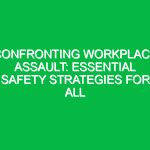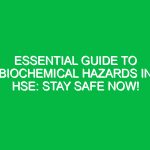Welcome, team! Today, we’re going to discuss an essential topic that directly impacts our health, safety, and environment in the construction industry: Dust Hazards. It’s crucial for us to understand the risks associated with dust exposure and how we can protect ourselves and our colleagues. So, let’s dive into this Toolbox Talk to ensure we work safely and effectively.
The Significance of Dust Hazards in Construction
Dust hazards in construction pose serious risks to our well-being. Whether it’s from cutting, drilling, grinding, or other activities, dust particles can lead to respiratory issues, skin irritation, eye problems, and even long-term health complications. By addressing these hazards proactively, we can create a safer work environment for everyone.
Identifying Dust Hazards
It’s essential to recognize the sources of dust in our work environment. From concrete and wood to metals and silica, various materials produce harmful dust particles when disturbed. By understanding the specific hazards associated with each material, we can take targeted measures to minimize exposure.
Health Impacts of Dust Exposure
Exposure to dust in construction can lead to a range of health issues, including respiratory diseases like silicosis, asthma, and bronchitis. Prolonged exposure can have severe consequences, affecting both our short-term well-being and long-term health. That’s why it’s crucial to protect ourselves against dust hazards at all times.
Preventive Measures for Dust Hazards
To safeguard ourselves and our colleagues from dust hazards, we must implement preventive measures consistently. This includes using proper ventilation, wearing personal protective equipment (PPE) such as masks and goggles, and regularly cleaning work areas to minimize dust accumulation. By following these practices diligently, we can reduce the risk of dust-related health issues.
Best Practices for Dust Control
Implementing effective dust control measures is key to mitigating hazards in construction. From using dust collection systems to wetting down surfaces before work, there are various strategies we can employ to minimize dust dispersion. By incorporating these best practices into our daily routines, we can create a safer and healthier work environment.
Regulations and Compliance
It’s crucial to adhere to relevant regulations and standards related to dust hazards in construction. By following guidelines set by regulatory bodies and our company policies, we not only ensure our safety but also fulfill legal obligations. Compliance is essential in maintaining a secure work environment for everyone.
Conclusion
As we conclude this Toolbox Talk on protecting against dust hazards in construction, remember that our health and safety are paramount. By staying informed, implementing preventive measures, and working together to minimize risks, we can create a workplace that prioritizes well-being. Thank you for your attention and dedication to maintaining a safe working environment. Let’s continue to prioritize safety in all our endeavors.


